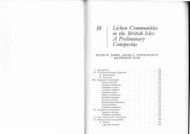Create successful ePaper yourself
Turn your PDF publications into a flip-book with our unique Google optimized e-Paper software.
The causes are many, the sensitivity to air<br />
pollution plays an important role.<br />
For <strong>Baden</strong>-<strong>Württemberg</strong> (valid also for the<br />
immediate environs) after the frequency<br />
statements the statement in parentheses about the<br />
endangerment is in the form <strong>of</strong> the number from<br />
the Red List. They mean<br />
0: Extinct or missing<br />
1: In danger <strong>of</strong> extinction<br />
2: Strongly endangered<br />
3: Endangered<br />
R: Extremely rare<br />
Annotations <strong>of</strong> the categories (according to the<br />
definitions <strong>of</strong> the BfN/Institute for vegetation<br />
studies):<br />
1: Species which are so severely endangered that<br />
they face extinction, if the threatening causes<br />
continue. One <strong>of</strong> the following criteria must be<br />
fulfilled: (1) the species is so considerably<br />
regressed that they are rare; the remaining<br />
population is endangered; (2) they are now rare<br />
and because <strong>of</strong> continuing human influence<br />
extraordinarily strongly endangered.<br />
2: Species, which are extensively regressing or<br />
because <strong>of</strong> continuing or foreseeable human<br />
influence are strongly endangered. One <strong>of</strong> the<br />
following criteria must additionally be fulfilled:<br />
(1) the species has already disappeared in the<br />
greater part <strong>of</strong> the region; (2) it is very rare to<br />
rare; (3) it is still moderately frequent, but<br />
strongly endangered; (4) the diversity <strong>of</strong> their<br />
formerly colonized habitat is extensively<br />
restricted.<br />
3: Species, which are moderately regressing or<br />
because <strong>of</strong> continuing or foreseeable human<br />
influence are endangered. One <strong>of</strong> the following<br />
criteria must additionally be fulfilled: (1) the<br />
species is already very rare in the greater part <strong>of</strong><br />
the region; (2) it is rare to moderately frequent;<br />
(3) it is still frequent, but strongly endangered;<br />
(4) the diversity <strong>of</strong> the formerly colonized habitat<br />
is restricted.<br />
R: Extremely rare species at this time. They are<br />
not appreciably regressed or not noticeably<br />
endangered and they may on the basis <strong>of</strong> their<br />
scarcity be suddenly destroyed or essentially<br />
decimated due to unforeseen developments, e.g.<br />
by a combination <strong>of</strong> unexpected human intrusion<br />
or natural events like rock slides. A statement in<br />
italics means that the classification must be seen<br />
as relatively uncertain. An asterisk (*) after the<br />
Red List Rating means that the species in the<br />
environs around <strong>Baden</strong>-Württem-berg is clearly<br />
less endangered.<br />
In the case <strong>of</strong> species not occurring in<br />
<strong>Baden</strong>-<strong>Württemberg</strong> (as a rule after the statement<br />
<strong>of</strong> natural area) the following symbol was used:<br />
+: extinct, (+++): in danger <strong>of</strong> becoming extinct,<br />
(++): strongly endangered, (+): endangered, *:<br />
extremely rare. Species with especially<br />
remarkable value <strong>of</strong> resistance to (mostly acid)<br />
air pollution were designated as toxic tolerant.<br />
4.5 Statements <strong>of</strong> Plant Geography<br />
For the characterization <strong>of</strong> plant areas one uses<br />
certain geographical statements in which<br />
particularly the north to south extending<br />
(zonation), in addition to the west to east<br />
extending (continents) and the elevational<br />
distribution. The clarification <strong>of</strong> the concepts<br />
used here comes from the following combination.<br />
The definition <strong>of</strong> the individual geographic<br />
regions is from the diagram (refer to MEUSEL,<br />
JAEGER & WEINERT).<br />
4.5.1 Floral Regions and Floral Elements<br />
(Europe)<br />
arct = arctic: Tundra region north <strong>of</strong> the polar<br />
tree line. Many <strong>of</strong> the species occurring in this<br />
region are also to be found in the alpine zone <strong>of</strong><br />
the vegetation zones lying further south<br />
(arct-alp).<br />
bor = boreal: Region <strong>of</strong> the boreal pine belt.<br />
The species occurring in this region are further<br />
found for the most part in the montane and high<br />
montane zones <strong>of</strong> the temperate (central<br />
European) zone.<br />
s’bor = southern boreal: Southern region <strong>of</strong> the<br />
boreal zone (narrowing toward the east).<br />
mieur = middle European (or temperate):<br />
Temperate zone, region <strong>of</strong> green summer<br />
deciduous forests (in part intermixed with pine<br />
forests).<br />
s’mieur = southern middle European: Southern<br />
region <strong>of</strong> the temperate zone.<br />
smed = sub-Mediterranean: Region <strong>of</strong> green<br />
summer dry forests (above all oak forests) and<br />
steppes, northern Mediterranean region.<br />
med = Mediterranean: Non deciduous evergreen<br />
and pine forests, steppes and semi-desert<br />
southern Mediterranean.<br />
atl = Atlantic: Deciduous forested region near<br />
the Atlantic (in central Europe eastern to NW<br />
Germany, central and upper Rhine).<br />
subatl = Sub Atlantic: Region <strong>of</strong> the deciduous<br />
forest <strong>of</strong> west and central Europe. Species in the<br />
24





